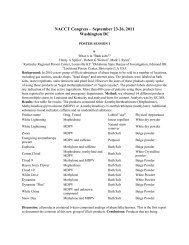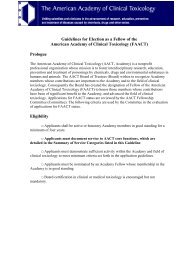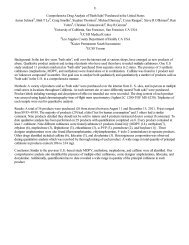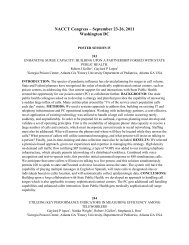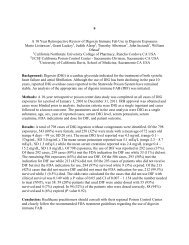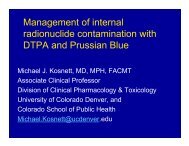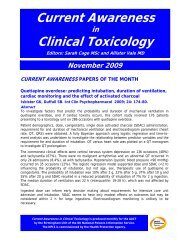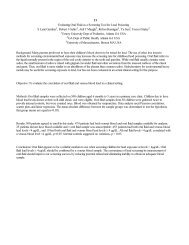Position Paper: Single-Dose Activated Charcoal - eapcct
Position Paper: Single-Dose Activated Charcoal - eapcct
Position Paper: Single-Dose Activated Charcoal - eapcct
Create successful ePaper yourself
Turn your PDF publications into a flip-book with our unique Google optimized e-Paper software.
74<br />
POSITION PAPER: SINGLE-DOSE ACTIVATED CHARCOAL<br />
significantly better at pH 7.2. This is to be expected since there<br />
is less ionization of fluoxetine at a more alkaline pH.<br />
Atta-Politou et al. (69) conducted an in vitro study to<br />
determine whether polyethylene glycol (PEG) and polyethylene<br />
glycol-electrolyte lavage (PEG-ELS) solution interfered<br />
with the adsorption of fluoxetine by activated charcoal. Two<br />
different brands of charcoal were used (Merck and Carbomix).<br />
Since fluoxetine is a basic compound, the study was<br />
conducted in simulated gastric solutions with pH values of<br />
1.2 and 7.2. PEG solutions of 1–20 mg/mL and a standard<br />
solution of PEG-ELS were combined with activated charcoal<br />
10 mg in a total volume of 10 mL. The PEG experimental<br />
solutions were added either simultaneously with the fluoxetine<br />
and activated charcoal or in a delayed fashion. The<br />
experimental solutions were incubated at 37° for 1 hour and<br />
then the free fluoxetine concentration was determined<br />
analytically. At pH 1.2 and with a charcoal to fluoxetine<br />
ratio of 6.06:1, 98.3–98.5% of the fluoxetine was adsorbed<br />
by activated charcoal. At pH 7.2 the adsorption was similar<br />
(98.7–99.7%). When the ratio of charcoal to fluoxetine was<br />
reduced to 3.03:1, the adsorption range at pH 1.2 was 63.4–<br />
64.1% and at pH 7.2 the adsorption range was 82.6–82.8%.<br />
When PEG was added in varying concentrations, the amount<br />
of fluoxetine that was adsorbed by charcoal was reduced in as<br />
the concentration of PEG was increased. When the PEG<br />
concentration was maximal (PEG: AC=2:1), at pH 1.2 and<br />
with a charcoal to fluoxetine ratio of 6.06:1, 29.1–39.1% of<br />
the fluoxetine was adsorbed by activated charcoal. At pH 7.2<br />
the adsorption range was 45.4–50.8%. When the ratio of<br />
charcoal to fluoxetine was reduced to 3.03:1, the adsorption<br />
range at pH 1.2 was 14.9–21.9% and at pH 7.2 the<br />
adsorption range was 44.9–46.2%. Statistical analysis was<br />
not conducted, but the data demonstrate large apparent<br />
reductions in the affinity of activated charcoal for fluoxetine<br />
in the presence of PEG. The study also shows the influence<br />
of ionization on the adsorptive capacity of activated charcoal.<br />
Atta-Politou et al. (70) conducted an in vitro investigation<br />
on the adsorption rate constant and the adsorption characteristics<br />
(affinity) of activated charcoal for fluoxetine. All<br />
fluoxetine solutions and charcoal slurries were prepared in<br />
an aqueous buffered solution with a pH of 1.2 to simulate the<br />
gastric environment. Varying amounts of activated charcoal<br />
from 0.125–0.500 g were added to the fluoxetine solution.<br />
The Langmuir adsorption isotherm model was used to determine<br />
the adsorption characteristics of charcoal for fluoxetine.<br />
Descriptive statistics were used to describe the results.<br />
The apparent adsorption rate constants increased by 64.8–<br />
75.7% as the amount of charcoal increased from a minimum<br />
of 0.125 g to a maximum of 0.500 g. Similarly, the maximum<br />
adsorption capacity of charcoal for fluoxetine ranged from<br />
254.8±1.8 to 439.8±8.5 mg/g of charcoal, demonstrating<br />
effective adsorption to activated charcoal. The authors<br />
concluded that charcoal adsorbs fluoxetine effectively and<br />
rapidly at gastric pH.<br />
Cooney and Thomason (71) conducted an in vitro study to<br />
determine the affinity of activated charcoal for fluoxetine<br />
hydrochloride at gastric pH’s. A stock solution of fluoxetine<br />
hydrochloride was admixed with varying (but not indicated)<br />
amounts of activated charcoal in simulated USP gastric<br />
solutions (without pepsin) with pH values of 1.2 and 7.5.<br />
The Langmuir adsorption isotherms and Freundlich equation<br />
were used to assess the affinity of charcoal for fluoxetine.<br />
Despite the fact that the pKa of fluoxetine HCl is ~9.1 and that<br />
97.55% of fluoxetine is still ionized at pH 7.5, the adsorption<br />
of fluoxetine by charcoal at pH 7.5 was superior to the<br />
adsorption characteristics at pH 1.2. For pH values of 1.2 and<br />
7.5, the amounts of fluoxetine adsorbed per gram of charcoal<br />
were 0.258 g and 0.330 g, respectively. Statistical analyses of<br />
the data were not conducted and no conclusions about in vivo<br />
applications can be extrapolated from this research.<br />
Hydrocarbons. <strong>Activated</strong> charcoal does adsorb hydrocarbons.<br />
When charcoal 3.6 g/kg was administered after oral<br />
instillation of hydrocarbon 8 mL/kg in rats, blood concentrations<br />
of kerosene were reduced significantly at all time<br />
points, i.e. 0.5, 1, 2, 4, 8, 12 hours (72). Since the ingestion of<br />
many aliphatic hydrocarbons, such as gasoline and kerosene,<br />
is not likely to produce toxicity other than that associated with<br />
aspiration, the use of charcoal in these ingestions is typically<br />
not warranted and may cause or contribute to emesis and<br />
potential complications.<br />
Ipecac. <strong>Activated</strong> charcoal adsorbs ipecac alkaloids (73).<br />
Despite a report that co-administration of ipecac syrup 60 mL<br />
and activated charcoal 50 g did not abate the emetic effect in<br />
poisoned patients (74), this approach is inconsistent with<br />
contemporary practice.<br />
Iron. Gomez et al. (75) conducted a prospective, crossover,<br />
controlled volunteer study to determine if activated charcoal<br />
or an activated charcoal-deferoxamine mixture could prevent<br />
the absorption of ferrous sulfate. The control group received<br />
ferrous sulfate 5 mg/kg as a solution. The subjects in the study<br />
limb ingested activated charcoal 25 g prior to the administration<br />
of the ferrous sulfate. Serum iron concentrations from<br />
blood samples obtained prior to iron ingestion and at 1, 2, 3, 4,<br />
5, 6, 7, 8, 10, 12, and 24 hours post-ingestion used to calculate<br />
the area under the curve. Maximum iron concentrations were<br />
also used for comparison of efficacy. The 11 subjects were not<br />
fasted completely. There was no statistical difference in the<br />
mean AUC between the control limb (13.39±5.0 mg-hour/L)<br />
and the activated charcoal limb (10.65±3.87 mg-hour/L). No<br />
statistical difference occurred in the Cmax between control<br />
(1.50±0.36 mg/L) and the activated charcoal limb (0.94±0.23<br />
mg/L), demonstrating that activated charcoal does not adsorb<br />
ferrous sulfate.<br />
Chyka et al. (76) studied the in vitro affinity of activated<br />
charcoal for ferrous sulfate in 3 simulated gastric fluids. Iron<br />
as ferrous sulfate was incubated with a control of Simulated<br />
Gastric Fluid, USP (pH 1.5), Simulated Gastric Fluid, USP<br />
(pH 7.5) and a combination of the acidic and alkaline gastric



